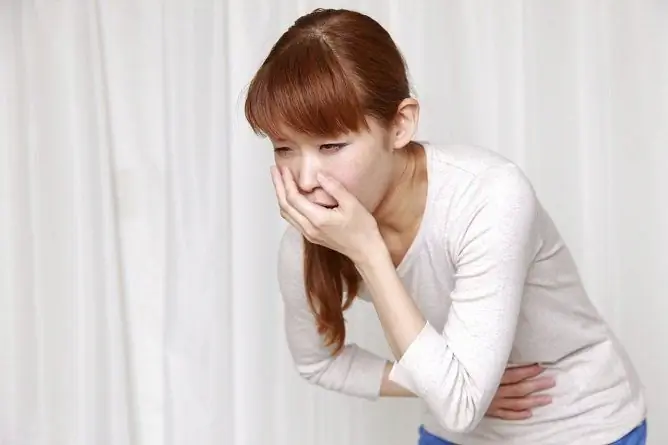- Author Rachel Wainwright [email protected].
- Public 2023-12-15 07:39.
- Last modified 2025-11-02 20:14.
Cough with phlegm: treatment, causes
The content of the article:
- Features of wet cough
- Causes of wet cough
- Diagnostic methods
- Sputum cough treatment
- Video
A cough with phlegm often accompanies diseases of the respiratory tract in children and adults. By itself, a cough is good for the body, as it performs a protective function. But the appearance of this symptom indicates the presence of a disease that needs to be treated.

With a wet cough, phlegm containing harmful substances is removed from the bronchi, so it cannot be suppressed
Features of wet cough
Coughing is a protective reflex that helps clear the airways. The abdominal muscles, larynx, and bronchial mucus are involved in the act of coughing.
With inflammatory diseases of the bronchi, the secretion of mucus increases. If a cough is accompanied by sputum production, it is called wet (wet, productive).
Sputum is a secret produced by the bronchial glands. Normally, phlegm facilitates the elimination of dust, bacteria, viruses and other foreign particles.
Sputum can be of a different nature:
- mucous membrane - abundant, transparent white, without pathological inclusions;
- purulent - yellow or green, with an unpleasant odor, contains a large number of leukocytes;
- vitreous - transparent, viscous;
- hemorrhagic - contains an admixture of blood.
The nature of the sputum can change with the course of the disease. Determining the nature of sputum allows one to suspect a primary disease, as well as determine the tactics of treatment.
Causes of wet cough
A wet cough indicates damage to the lower respiratory tract (bronchi, bronchioles, alveoli). Common causes of phlegm cough:
- acute bronchitis;
- Chronical bronchitis;
- bronchial asthma;
- pneumonia;
- tuberculosis;
- bronchiectasis;
- lung cancer.
Acute bronchitis is an inflammatory disease of the bronchi. Often the cause of inflammation is viral and bacterial infections, which are transmitted by airborne droplets. For acute bronchitis, a cough is characteristic, which is accompanied by the release of mucous sputum. In addition to coughing, there is an increase in temperature to subfebrile numbers, less often - symptoms of intoxication. In acute bronchitis, the cough lasts no longer than two weeks.
Chronic bronchial inflammation is also accompanied by a moist cough. Chronic bronchitis is more common in adults. The reasons may be different: bacterial infection, smoking, occupational hazards. Often in chronic bronchitis, the sputum is purulent or mucopurulent. The cough is lingering, lasts more than 8 weeks. The temperature rises only during an exacerbation.
In bronchial asthma, the sputum is viscous, glassy. Other symptoms are also disturbing - shortness of breath, a feeling of squeezing the chest. The cough worsens at night, has a paroxysmal character.
Inflammation of the lungs (pneumonia) can also be accompanied by a severe wet cough. The symptom appears at the onset of the disease. However, in the foreground with pneumonia, it is not a cough, but signs of intoxication - high fever, general weakness, and increased fatigue. With inflammation of an entire segment or lobe of the lung, shortness of breath and other signs of respiratory failure may occur.
A prolonged cough may indicate tuberculosis. Other symptoms are characteristic of tuberculosis - low-grade fever, excessive sweating, weight loss, general weakness and lethargy. Tuberculosis cough persists for more than 2-4 weeks. The sputum is mucous, streaked with blood. In adults, pulmonary tuberculosis is more common, in children - tuberculous intoxication, tuberculosis of the intrathoracic lymph nodes.
Abundant sputum production is characteristic of bronchiectasis. It is a chronic disease characterized by expansion and deformation of the bronchi. Bronchial mucus is not excreted, but stagnates in the bronchi. A purulent sputum with an unpleasant odor is released. The cough is worse when lying down, at night and in the morning.
Excretion of sputum streaked with blood is characteristic of tumor lesions of the lungs. With lung cancer, other symptoms are observed - shortness of breath, weight loss, symptoms of intoxication. A productive cough rarely indicates a malignant lung disease, but if additional symptoms appear, it is better to get tested.
Diagnostic methods
An examination is required to establish the cause of the cough. At the first stage of diagnosis, general clinical methods are used:
- complete blood count (CBC);
- plain chest x-ray.
With the help of the KLA, signs of inflammation can be detected. An active inflammatory process is indicated by an increase in the level of leukocytes, erythrocyte sedimentation rate (ESR). With the viral nature of the disease, the level of lymphocytes increases, with the bacterial nature - neutrophils. A significant acceleration of ESR should alert, as it may indicate a malignant process or a severe infection.
With the help of a plain radiograph, one can suspect damage to the bronchi, lung tissue. Strengthening of the pulmonary pattern, expansion of the roots of the lungs is characteristic of bronchitis. The presence of a focal shadow indicates pneumonia or tuberculous lesion.

Evaluation is necessary, as a productive cough can be caused by various reasons
In 90% of cases, general clinical methods are sufficient for diagnosis. In other cases, more narrow studies are assigned to confirm the etiology of cough, including:
- sputum examination (microscopic, bacteriological);
- bronchography;
- bronchoscopy;
- allergic tests;
- tuberculin tests.
Microscopic examination of sputum reveals its nature, consistency, the presence of impurities and cellular composition. The presence of Kurshman's spirals, a large number of eosinophils, Charcot-Leiden crystals indicates bronchial asthma. A large number of leukocytes in sputum may indicate chronic bronchitis, bronchiectasis, or abscess. In lung cancer, abnormal cells are found in the sputum.
Bacteriological examination of sputum allows you to confirm the bacterial nature of the disease, as well as the sensitivity of the pathogen to antibiotics. Sputum is sown on life-giving media.
Bronchography is used when bronchiectasis is suspected. This is a contrast research method that allows you to identify the expansion and deformation of the bronchi.
If chronic bronchitis is suspected, an endoscopic research method is used - bronchoscopy. With its help, you can determine the state of the bronchial mucosa.
Allergic tests are prescribed for suspected bronchial asthma. With the help of a test, you can identify allergens that lead to an exacerbation of the disease.
To diagnose tuberculosis, the Mantoux test, polymerase chain reaction (PCR) is used.
Sputum cough treatment
It is contraindicated to suppress a wet cough, as this can lead to the accumulation of sputum and its infection.
The main direction of therapy is the stimulation of sputum excretion. For this purpose, expectorant drugs and inhalation are used.
The action of expectorant drugs is aimed at facilitating the excretion of sputum. There are two main types of expectorants:
- secretomotor;
- mucolytics.
Secretomotor drugs help remove phlegm. They activate the work of cilia - outgrowths of the bronchial mucosa, which remove mucus and foreign particles from the bronchi. Some herbal preparations have a secretomotor effect, for example, thermopsis herb, marshmallow root.
Mucolytics help to thin the phlegm. They are used for wet coughs when the phlegm is too viscous. Mucolytics include Acetylcysteine, Bromhexine, Ambroxol.
To treat a child's cough, expectorant drugs in the form of a syrup are used, for example, Lazolvan, Alteika.
It is contraindicated to combine the intake of mucolytics and antitussive drugs. This inhibits expectoration, leads to the accumulation of bronchial secretions and creates favorable conditions for the attachment of bacterial flora.
Inhalation is used to moisturize the mucous membrane and reduce the viscosity of sputum. The simplest, but also less effective method is steam inhalation (not used in children); it is better to use a nebulizer. You can use alkaline solutions, water with soda, saline, etc.
Increased fluid intake helps to facilitate the elimination of phlegm. You can drink plain water, green tea, decoctions of herbs and rose hips, warm milk with honey.
Cough is not a separate disease, therefore, treatment should be aimed not so much at eliminating the cough as at getting rid of the primary disease.
In acute viral bronchitis, specific cough treatment is not performed. It is enough to take expectorant drugs, bed rest and increased fluid intake.

Drinking more fluids for better coughing up
Treatment of chronic bronchitis is carried out taking into account the etiological factor. In addition to expectorant drugs, chest drainage and breathing exercises are used. With the bacterial nature of bronchitis, antibacterial agents are prescribed. At first, the antibiotic is selected empirically, most often drugs from the penicillin group are used. For example, Amoxicillin, Amoxiclav. After receiving the results of bacteriological examination of sputum, antibiotic therapy is adjusted.
Treatment of cough in bronchial asthma has several directions. The main task is to eliminate the influence of allergens. Medical treatment is selected depending on the stage of the disease. At the initial stage, inhalation drugs are used that expand the lumen of the bronchi. For example, Berotek, Salbutamol. Later, their intake is combined with anti-inflammatory drugs - Ingakort, Nedokromil.
With pulmonary tuberculosis, specific antibiotic therapy is prescribed. Treatment is carried out in a hospital setting. Before prescribing drugs, the sensitivity of the mycobacterial bacillus is examined. First-line drugs include Rifampicin, Ethambutol, Pyrazinamide and Isoniazid. Anti-tuberculosis therapy is selected only by a doctor.
For bronchiectasis, mucolytics, antibiotics, and inhaled bronchodilators are prescribed. Mucolytics (Ambroxol, Acetylcysteine) facilitate the excretion of sputum, eliminate its stagnation. Antibacterial drugs reduce the signs of inflammation. Antibiotics from the group of cephalosporins are prescribed - Cefazolin, Cefepim, Cefuroxime. Bronchodilators widen the bronchial lumen and make breathing easier. For treatment, Salbutamol or Ipratropium bromide is used. A chest drainage massage is also used. To clean the bronchi, instrumental methods are used, for example, bronchoalveolar lavage during bronchoscopy. With massive lesions, surgery may be indicated.
Video
We offer for viewing a video on the topic of the article.

Anna Kozlova Medical journalist About the author
Education: Rostov State Medical University, specialty "General Medicine".
Found a mistake in the text? Select it and press Ctrl + Enter.






